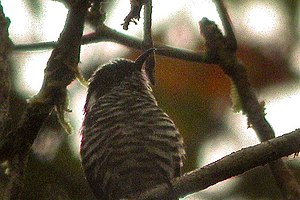Red-winged bronze cuckoo
| Red-winged bronze cuckoo | ||||||||||
|---|---|---|---|---|---|---|---|---|---|---|

Red-winged bronze cuckoo ( Chrysococcyx meyerii ) |
||||||||||
| Systematics | ||||||||||
|
||||||||||
| Scientific name | ||||||||||
| Chrysococcyx meyerii | ||||||||||
| Salvadori , 1874 |
The red-winged bronze cuckoo ( Chrysococcyx meyerii , syn .: Chrysococcyx meyeri , Chalcites meyerii ) is a species of cuckoo that occurs in New Guinea . The scientific name honors the discoverer of the species, the ornithologist Adolf Bernhard Meyer .
features
The red-winged bronze cuckoo is a small cuckoo that grows to around 15 cm. The top of the plumage is shiny green with brown shimmering areas. The ear patch is white. The breast is white with green-brown sparrows . It is named after the striking red hand wings. The sexual dimorphism is not very pronounced, the female, in contrast to the male, has a red-brown forehead area.
distribution
The red-winged bronze cuckoo is only found in New Guinea . In contrast to its sympatric close relative, the red-necked bronze cuckoo , it inhabits lower lying areas of the island. No population size estimates are available, however, due to the size of the distribution area, no endangerment of the species is assumed.
Way of life
The preferred habitats of the red-winged bronze cuckoo are forests and gardens of the lowlands. The diet consists mainly of caterpillars that are pecked by leaves. Like all other Chrysococcyx species , the red-winged bronze cuckoo is probably a breeding parasite .
Etymology and history of research
Adolf Bernhard Meyer (1840–1911) used the name Chrysococcyx splendidus for the red-winged bronze cuckoo when it was first described . He had brought the type specimen back from his trip from New Guinea . When the Italian government of Luigi Maria d'Albertis (1841–1901) bought a collection of 650 bellows of around 190 types, Tommaso Salvadori (1835–1923) was given the task of describing them. In his analysis, Salvadori found that George Robert Gray had already used Cuculus splendidus for the emerald cuckoo (now Chrysococcyx cupreus ). That is why he dedicated the new name to his first discoverer in order to do justice to the international rules for zoological nomenclature .
The name Chrysococcyx is composed of the Greek words khrusos for gold and kokkux for cuckoo .
literature
- Johannes Erritzoe, Clive F. Mann, Frederik Brammer, Richard A. Fuller: Cuckoos of the World (Helm Identification Guides). Christopher Helm Publishers Ltd, London 2012, ISBN 978-071-366-034-0 .
- James A. Jobling: Helm Dictionary of Scientific Bird Names . Christopher Helm, London 2010, ISBN 978-1-4081-2501-4 .
- Adolf Bernhard Meyer: About new and insufficiently known birds from New Guinea and the islands of the Geelvinksbai . In: Meeting reports of the Imperial Academy of Sciences. Mathematical and natural science class. Dept. 1, Mineralogy, Botany, Zoology, Geology and Paleontology. tape 69 , 1874, pp. 74-90 ( online [accessed September 19, 2012]).
- Tommaso Salvadori: Altre nouve specie di uccelli della Nuova Guinea e di Goram raccolte dal Signor LM D'Albertis . In: Annali del Museo civico di storia naturale di Genova . tape 6 , 1874, pp. 81-88 ( online [accessed September 19, 2012]).
Web links
- Chalcites meyerii inthe IUCN 2012 Red List of Threatened Species . Listed by: BirdLife International, 2012. Retrieved September 19, 2012.
- BirdLife International: Species Factsheet - White-eared Bronze-cuckoo ( Chalcites meyerii ) . Retrieved September 19, 2012.
- Videos, photos and sound recordings of White-eared Bronze-Cuckoo (Chrysococcyx meyeri) in the Internet Bird Collection
- Red-winged bronze cuckoo ( Chalcites meyerii ) at Avibase; Retrieved September 19, 2012.
- Chrysococcyx meyeri in the Integrated Taxonomic Information System (ITIS). Retrieved September 19, 2012.
- xeno-canto: Sound recordings - White-eared Bronze-cuckoo ( Chrysococcyx meyerii )
Individual evidence
- ↑ Bo Beolens, Michael Watkins: Whose Bird? Men and Women Commemorated in the Common Names of Birds . Christopher Helm, London 2003, ISBN 0-7136-6647-1 , pp. 205 .
- ↑ a b c Erritzoe et al. P. 367
- ↑ Chalcites Meyerii in the endangered Red List species the IUCN 2012. Posted by: BirdLife International, 2012. Accessed September 12, 2012 found.
- ^ Adolf Bernhard Meyer, p. 81.
- ^ Adolf Bernhard Meyer, p. 74
- ↑ a b Tommaso Salvadori, p. 82.
- ↑ James A. Jobling, p. 105